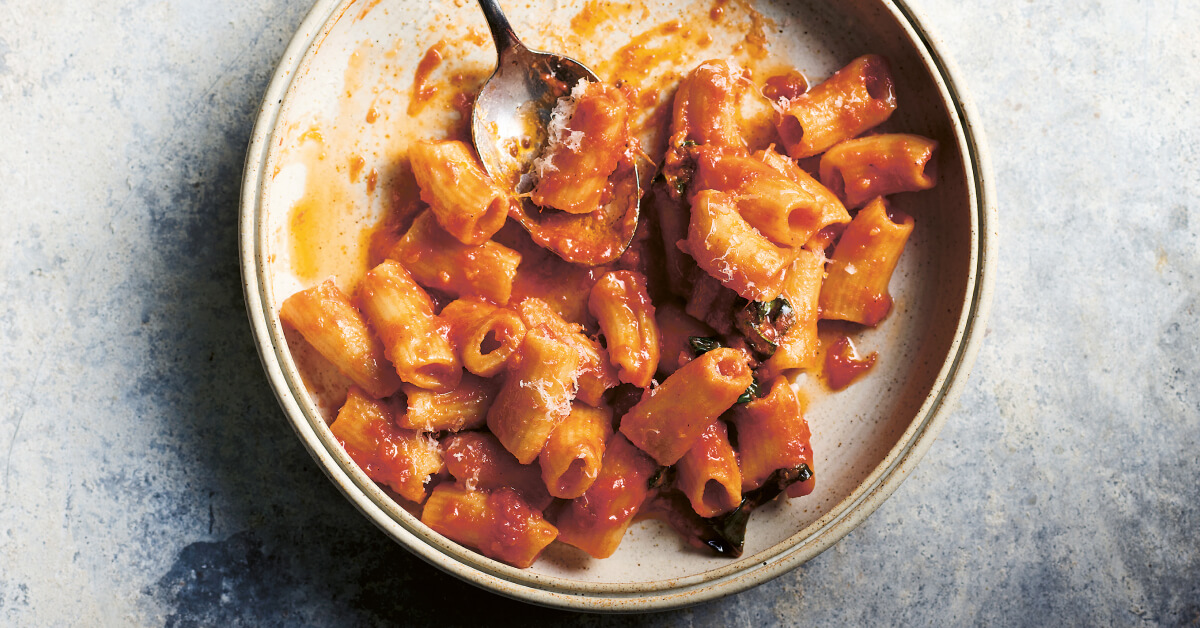Recipe & pairing | Andreas Papadakis' (Tipo 00 The Pasta Cookbook) Rigatoni pomodoro

Greek chef Andreas Papadakis opened his tiny, cultish Melbourne pasta bar because he couldn't find what he wanted: an exceptional bowl of pasta made with the very best ingredients and served all day. The restaurant - named for the one true pasta flour - has always been about good food, excellent wine, and 10/10 hospitality. Here’s a recipe for rigatoni pomodoro from his debut cookbook (available now) that’s as simple or complex as you want to make it. That goes for the wine pairing too - and however it is you’re doing this dish, we’ve got a couple of picks in mind.
Pairing tip: "Very much a choose your own adventure here, especially if you’re being adventurous and making the pasta from scratch. For me it has to be a red wine, and basic as it may be, you don’t mess with the classics; I’m reaching for something made in (or inspired by) Italy. For special occasions I’d be opting for a sultry aged Barolo, Brunello or Chianti, but if this is a midweek quick go-to let’s not overcomplicate things - a sangiovese from McLaren Vale would be bellissimo. Same goes for any barbera, nebbiolo or Old Country blend that you’ll find closer to home in Aus. Full belly, full glass - a taste of la dolce vita, any night of the week." - Nick
Try this with:
Red Blend 2022 – Black Market Deal #51323
Lush and loveable Italian blend, this is a charismatic Heathcote combo with floral flair and a firm finish. So balanced, it's a bit like taking a road trip through a selection of Italy's best vineyards, bursting with flavour and zeal. This combo is a truly quintessential dry red that's fresh, fruity and perfectly pulpy. You'll get bursts of cherry and even a hint of black tea and cedar on the end that round out its delicious character. Pair it with tomato based pastas and enjoy the symphony.
Riecine di Riecine Rosso Toscana IGT 2017
Unbeatable sangiovese - full bodied and ripe with a rich earth backbone. Grapes from the oldest Riecine vineyards are hand picked and selected, then lightly crushed for a long maceration (20-30 days) in concrete. It's then aged to perfection for 36 months in concrete Nomblot egg tanks. Firm and superbly elegant, with supple tannins and a tongue-tickling backbone of acidity that sees it singing with excitement. All the classical Chianti fruits are here, but beautifully precise and unmuddled. It’s like each individual berry is discernible to taste. Approachable right now, it’ll nevertheless age stylishly for ever more complexity.

Rigatoni pomodoro
This is a quick and light dish that has become my go-to when hungover, as it’s so easily pulled together, especially if you have a batch of Napoli tomato sauce in the freezer and some dried rigatoni in the cupboard. It’s also something the kids are always happy to eat. If you feel like making your own rigatoni, follow the method below and cut the pasta into 4 cm x 3 cm (1½ inch x 1¼ inch) rectangles and roll each one across your ribbed wooden board, aligning the longer sides with the grooves and wrapping the pasta around your wooden dowel to form a tube.
SERVES 2
5 tablespoons olive oil, plus extra to serve
1 small clove of garlic, finely grated
200 ml (7 fl oz) Napoli tomato sauce (below)
225 g (8 oz) quality dried rigatoni
2 tablespoons finely grated parmesan
4–5 basil leaves
Warm the olive oil in a pan over medium-low heat, add the garlic and cook gently until the garlic has just softened but not coloured. Add the tomato sauce and bring to a slow simmer.
In the meantime, cook the rigatoni in plenty of boiling salted water until al dente, according to the instructions on the package. Drain the pasta (reserving some of the pasta water) and add to the sauce, then toss everything together for 30 seconds until the pasta is well coated. Add the parmesan and basil and toss a couple more times, adding a little of the reserved pasta water to adjust the consistency of the sauce, if needed. Serve in warmed bowls and finish with a drizzle of olive oil.
Napoli tomato sauce
MAKES ABOUT 2 LITRES (8 CUPS)
80 ml (⅓ cup) olive oil
1 brown onion, finely diced
2 cloves of garlic, crushed
3 x 400 g (14 oz) tins of peeled tomatoes, ideally San Marzano
basil leaves from 2–3 sprigs
sea salt
Heat the olive oil in a large saucepan over medium-low heat, then add the onion and garlic and cook until soft and translucent, around 6–8 minutes. Add the tomatoes and stir well, then bring to a slow simmer. Turn the heat down to low and cook for 1 hour, stirring occasionally to make sure the sauce doesn’t catch on the bottom. Taste and season with salt, then take off the heat and let the sauce rest for 15 minutes before you add the basil. We normally pass this sauce through a vegetable mill while it’s still hot. If you don’t have one, you can just use a whisk to crush the tomatoes – don’t be tempted to blitz the sauce with a blender, or you’ll lose its pleasingly rustic texture.
Rigatoni
½ quantity master pasta dough (see below), rolled into sheets 2–3 mm (1⁄8 inch) thick olive oil
cracked black pepper
finely grated parmesan, to serve
To shape the rigatoni, lay out the pasta sheets on a lightly floured bench and cut into 4 cm x 3 cm (1½ inch x 1¼ inch) rectangles. Place a pasta rectangle on the ribbed wooden board, then wrap the pasta around the dowel diagonally as you roll it across the board, pressing firmly at the join. Pull the pasta off the dowel and set aside on a semolina dusted surface. Repeat until all the rigatoni are made, then leave to dry for 3–4 hours.
Master Pasta Dough
If using an electric mixer, place both flours and the salt in the bowl of a mixer fitted with the dough hook attachment. Make a well in the centre and add the egg yolk and whole egg. (I find it easiest to weigh the egg yolks in a clean bowl first and then add the whole eggs to the same bowl up to the total amount of eggs, which is 255 g (9 oz) for this recipe. The total amount of egg is the important part.) Mix on slow speed for 8–10 minutes, until you start seeing large crumbs forming and the dough starts coming together. Transfer the dough to a clean benchtop and knead by hand until it comes together. Don’t expect it to be really smooth, as this is a drier dough – it will come together more and get smoother in the rolling process.
To make the dough by hand, combine both flours and the salt in a mixing bowl. Make a well in the centre and add the egg yolk and whole egg. Mix with a fork until just combined, then transfer to a clean benchtop and knead by hand for 6–8 minutes until the dough comes together.
If the dough seems too dry and won’t come together, you can spray it a couple of times with your spray bottle of water – just be careful not to overdo it and make the dough too wet, since it will become more hydrated and softer as it rests.
I like to shape the dough into a roughly rectangular block, rather than a ball, as I find it easier to feed through the pasta machine later. Wrap your dough really well in plastic film, making it as airtight as possible (at the restaurant we use a vacuum sealer).
If you are planning to make your pasta straight away, let the dough rest for at least an hour at room temperature – but ideally refrigerate it overnight, then take it out a couple of hours before rolling and cutting to let it come back to room temperature.
To make the rolling more manageable, it’s best to work with a relatively small amount of dough, so divide it in two before you start. (If you are not using all the dough at once, you can refrigerate the rest of it, tightly wrapped, for up to 3 days.)
MAKES ENOUGH PASTA FOR 4–6
350 g (12 oz) ‘00’ flour
150 g (5½ oz) durum wheat semolina flour
1 teaspoon sea salt
65 g (2¼ oz) egg yolk (from about 3–4 eggs)
190 g (6¾ oz) whole egg (about 4 eggs)
ROLLING AND FOLDING THE DOUGH
Set up the pasta machine on a solid benchtop. Using your hands or a rolling pin, flatten the dough enough that it will go through the widest setting on the pasta machine, then pass it through the rollers two or three times, going down one notch each time.
Bring both sides of the dough to the centre, so they meet in the middle, then fold in half to create four layers of dough.
Roll the dough through the widest setting again, then repeat the folding and rolling process one more time – but this time bring one third of the dough into the centre, laying it over the middle third, then cover with the last third to create three layers.
Flatten the dough again, so that it will go through the widest setting on your machine, then pass it through the rollers, going down one notch at a time; it should be smooth by now and starting to become elastic. Keep going until the pasta sheets are the thickness you need: for filled pasta, you want a 1–1.5 mm (1/16 inch) thickness, and for long and short shapes, 2–3 mm (1/8 inch).
CUTTING AND SHAPING THE DOUGH
For long pasta (such as spaghetti and tagliatelle), the sheets are cut into strips using the cutter attachment on your pasta machine (if it has one) or a sharp knife.
For shaped pasta (such as garganelli), the sheets are cut into squares with a pasta wheel and then formed into shapes.
For filled pasta (such as tortelloni and ravioli), the sheets are also cut into squares or circles before being filled and sealed.
And for more rustic kinds of pasta (such as fusilli al ferretto and orecchiette), the dough is not machine-rolled into sheets at all, but simply shaped by hand.

Images and text from “Tipo 00 The Pasta Cookbook” by Andreas Papadakis, photography by Mark Roper, illustrations by Robin Cowcher. Murdoch Books RRP $49.99.